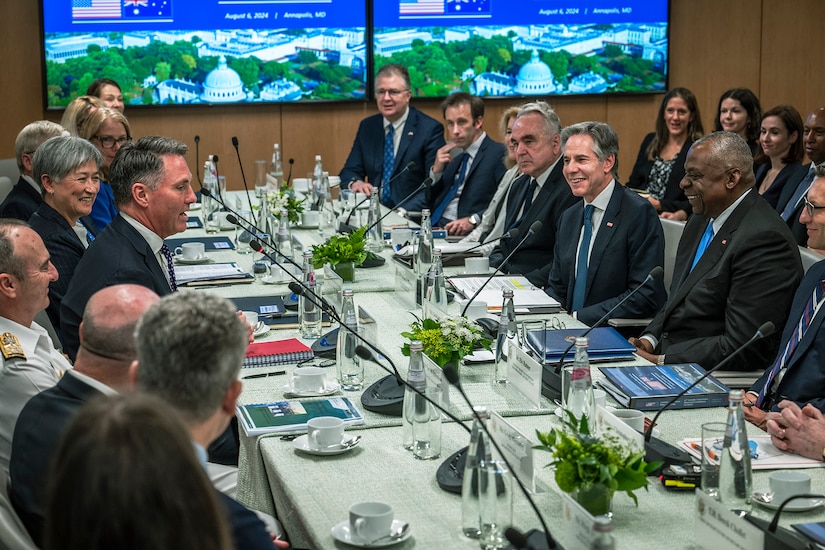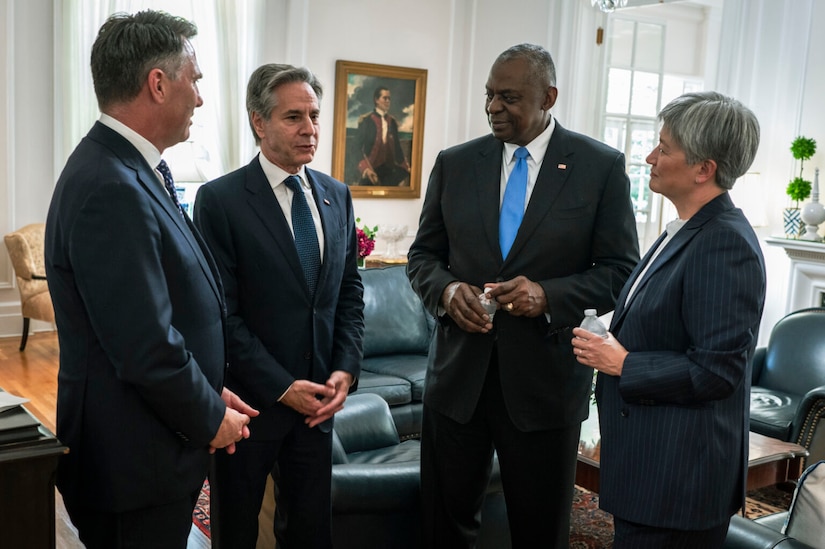Secretary of Defense Lloyd J. Austin III reaffirmed the impenetrable bond between the U.S. and Australia after hosting high-level talks today with key Australian officials.

Austin and Secretary of State Antony Blinken hosted their Australian counterparts, Defense Minister Richard Marles and Minister for Foreign Affairs Penny Wong, at the U.S. Naval Academy in Annapolis, Maryland, for the 34th Australia-U.S. Ministerial Consultations, or AUSMIN.
The officials announced new steps to enhance force posture and defense industrial cooperation between the U.S. and Australia, further building upon recent strides in the longstanding alliance.
“Today’s meetings have once again demonstrated the extraordinary strength of our unbreakable alliance with Australia,” Austin said during a joint news conference following the talks.
He added that today’s discussions were guided by the U.S. and Australia’s common vision for a free and open Indo-Pacific.
Austin also announced the two countries are taking steps to deepen force posture cooperation with upgrades to critical air bases in Western Australia and the Northern Territory.
“We’re also increasing the presence of rotational U.S. Forces in Australia,” he said. “All this will mean more maritime patrol aircraft and reconnaissance aircraft operating from bases across northern Australia. It will also mean more frequent rotational bomber deployments.”
The U.S. and Australia are also increasing defense industrial base cooperation.
Austin announced that the two countries are aiming to sign memorandums of understanding by the end of the year that will support in the production of critical munitions.
One agreement would support the manufacturing of Guided Multiple Launch Rocket Systems in Australia by 2025.
A second agreement would support the co-production, co-sustainment and co-development of the Precision Strike Missile. The two countries have agreed to stand up a joint program office for that endeavor in early 2025.
“Together, these efforts will help ensure that we have the capability and the capacity that we’ll need for decades to come,” Austin said.

Austin said both countries will also continue to advance their defense ties with other regional allies and partners throughout the Indo-Pacific and build upon the trilateral AUKUS security partnership with the U.K.
“We got a lot done today,” Austin said. “We’ll keep building on our joint achievements over the past 3 1/2 years. And we’ll keep charting an ambitious course forward.”
Today’s talks in Annapolis cap a series of engagements with key allies in the Indo-Pacific over the past 10 days as the Defense Department continues to strengthen partnerships to support a shared vision for peace, stability and deterrence throughout the region.
Last week, Austin concluded his 11th visit to the region with stops in Japan and the Philippines where he met alongside Blinken with key allies throughout the region.
While in Japan, the two U.S. officials met with Japanese Defense Minister Minoru Kihara and Foreign Minister Yoko Kamikawa as part of this year’s U.S.-Japan Security Consultative Committee meeting in Tokyo.
Austin and Kihara also met separately with South Korea’s defense minister for a trilateral meeting, a key component of the U.S., South Korea and Japan security cooperation dialogue.
From Tokyo, Austin and Blinken traveled to Manila, the Philippines, where they met with Defense Secretary Gilberto Teodoro and Foreign Secretary Enrique Manalo as part of the dialogue as part of the fourth Philippines-United States 2+2 Ministerial Dialogue.
The series of engagements mark a continuation of President Joe Biden’s strategy of sustained engagement in the United States’ priority theater of operations.
In previewing Austin’s trip, a senior defense official remarked that it would represent “the 10 most consequential days for U.S. defense ties in the Indo-Pacific since the start of the administration.”

“AUSMIN marks Day 10, and I think you’ll find that, amid a crowded news cycle, we were right,” the official said yesterday ahead today’s talks in Annapolis.
“This administration has spent the past three-and-a-half years delivering major results with Indo-Pacific allies and partners, and these 10 days are all about taking that work to the next level,” he said.

